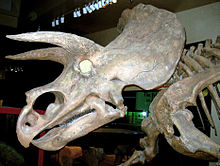
Ceratopsidae
Did you know...
SOS Children volunteers helped choose articles and made other curriculum material SOS mothers each look after a a family of sponsored children.
| Ceratopsids Temporal range: Late Cretaceous |
|
|---|---|
 |
|
| Triceratops skull | |
| Scientific classification | |
| Kingdom: | Animalia |
| Phylum: | Chordata |
| Class: | Sauropsida |
| Superorder: | Dinosauria |
| Order: | Ornithischia |
| Suborder: | Cerapoda |
| Infraorder: | Ceratopsia |
| Family: | Ceratopsidae Marsh, 1890 |
| Subfamilies | |
|
|
Ceratopsidae (sometimes spelled Ceratopidae) is a speciose group of marginocephalian dinosaurs including Triceratops and Styracosaurus. All known species were quadrupedal herbivores from the Upper Cretaceous of Western North America and are characterized by beaks, rows of shearing teeth in the back of the jaw, and elaborate horns and frills. The group is divided into two subfamilies. The Ceratopsinae or Chasmosaurinae are generally characterized by long, triangular frills and well-developed brow horns. The Centrosaurinae had well-developed nasal horns or nasal bosses, shorter and more rectangular frills, and elaborate spines on the back of the frill.
These horns and frills show remarkable variation and are the principal means by which the various species have been recognized. Their purpose is not entirely clear. Defense against predators is one possible purpose - although the frills are comparatvely fragile in many species - but it is more likely that, as in modern ungulates, they may have been secondary sexual characteristics used in displays or for intraspecific combat. The massive bosses on the skulls of Pachyrhinosaurus and Achelosaurus resemble those formed by the base of the horns in modern musk oxen, suggesting that they may have butted heads. Centrosaurines have frequently been found in massive bone beds with few other species present, suggesting that the animals might have lived in large herds.
Taxonomy
- Family Ceratopsidae
- Subfamily Centrosaurinae
- Achelousaurus - ( Montana, USA)
- Albertaceratops - ( Alberta, Canada & Montana, USA)
- ? Avaceratops - ( Montana, USA)
- Brachyceratops - ( Montana, USA & Alberta, Canada)
- Centrosaurus - ( Alberta, Canada)
- Einiosaurus - ( Montana, USA)
- Monoclonius - ( Montana, USA & Alberta, Canada)
- Pachyrhinosaurus- ( Alberta, Canada & Alaska, USA)
- Styracosaurus - ( Alberta, Canada & Montana, USA)
- Subfamily Ceratopsinae (= Chasmosaurinae)
- Agujaceratops - ( Texas, USA)
- Anchiceratops - ( Alberta, Canada)
- Arrhinoceratops - ( Alberta, Canada)
- ? Ceratops - ( Montana, USA & Alberta, Canada)
- Chasmosaurus - ( Alberta, Canada)
- Diceratus - ( Wyoming, USA)
- Eotriceratops - ( Alberta, Canada)
- Pentaceratops - ( New Mexico, USA)
- Torosaurus - ( Wyoming, Montana, South Dakota, North Dakota, Utah & Saskatchewan)
- Triceratops - Montana, Wyoming, USA & Saskatchewan, Alberta, Canada.
- Subfamily Centrosaurinae
